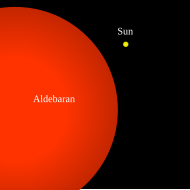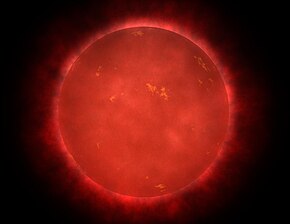
Back بوابة:نجوم Arabic Portail:Étoiles French Portal:Bintang ID Portale:Stelle Italian Portal:Estrelas Portuguese Portal:Stea Romanian Проект:Астрономические объекты/Звёзды Russian Portál:Hviezda Slovak Cổng thông tin:Sao Vietnamese Portal:恒星 Chinese
IntroductionA star is a luminous spheroid of plasma held together by self-gravity. The nearest star to Earth is the Sun. Many other stars are visible to the naked eye at night; their immense distances from Earth make them appear as fixed points of light. The most prominent stars have been categorised into constellations and asterisms, and many of the brightest stars have proper names. Astronomers have assembled star catalogues that identify the known stars and provide standardized stellar designations. The observable universe contains an estimated 1022 to 1024 stars. Only about 4,000 of these stars are visible to the naked eye—all within the Milky Way galaxy. A star's life begins with the gravitational collapse of a gaseous nebula of material largely comprising hydrogen, helium, and trace heavier elements. Its total mass mainly determines its evolution and eventual fate. A star shines for most of its active life due to the thermonuclear fusion of hydrogen into helium in its core. This process releases energy that traverses the star's interior and radiates into outer space. At the end of a star's lifetime as a fusor, its core becomes a stellar remnant: a white dwarf, a neutron star, or—if it is sufficiently massive—a black hole. Stellar nucleosynthesis in stars or their remnants creates almost all naturally occurring chemical elements heavier than lithium. Stellar mass loss or supernova explosions return chemically enriched material to the interstellar medium. These elements are then recycled into new stars. Astronomers can determine stellar properties—including mass, age, metallicity (chemical composition), variability, distance, and motion through space—by carrying out observations of a star's apparent brightness, spectrum, and changes in its position in the sky over time. Stars can form orbital systems with other astronomical objects, as in planetary systems and star systems with two or more stars. When two such stars orbit closely, their gravitational interaction can significantly impact their evolution. Stars can form part of a much larger gravitationally bound structure, such as a star cluster or a galaxy. (Full article...) Selected star - Photo credit: commons:user:Riffsyphon1024 and commons:user:Mysid
Aldebaran (α Tau, α Tauri, Alpha Tauri) is a red giant star located about 65 light years away in the zodiac constellation of Taurus. With an average apparent magnitude of 0.87 it is the brightest star in the constellation and is one of the brightest stars in the nighttime sky. The name Aldebaran is Arabic (الدبران al-dabarān) and translates literally as "the follower", presumably because this bright star appears to follow the Pleiades, or "Seven Sisters" star cluster in the night sky. In 1997 a substellar companion was reported but subsequent observations have not confirmed this claim. Aldebaran is classified as a type K5III star. It is an orange giant star that has moved off the main sequence line of the Hertzsprung–Russell diagram. It has exhausted the hydrogen fuel in its core and hydrogen fusion has ceased there. Although not yet hot enough for fusing helium, the core temperature of the star has greatly increased due to gravitational pressure and the star has expanded to a diameter of 44.2 times the diameter of the Sun,Richichi & Roccatagliata (2005) derived an angular diameter of 20.58±0.03 milliarcsec, which given a distance of 65 light years yields a diameter of 61 million km.</ref> approximately 61 million kilometres (see 10 gigametres for similar sizes). The Hipparcos satellite has measured it as 65.1 light-years (20.0 pc) away, and it shines with 150 times the Sun's luminosity. Aldebaran is a slightly variable star, of the slow irregular variable type LB. It varies by about 0.2 in apparent magnitude. Selected article - Photo credit: NASA, ESA, AURA/Caltech, Palomar Observatory
In astronomy, the Pleiades, or Seven Sisters (Messier object 45), is an open star cluster containing middle-aged hot B-type stars located in the constellation of Taurus. It is among the nearest star clusters to Earth and is the cluster most obvious to the naked eye in the night sky. Pleiades has several meanings in different cultures and traditions. The cluster is dominated by hot blue and extremely luminous stars that have formed within the last 100 million years. Dust that forms a faint reflection nebulosity around the brightest stars was thought at first to be left over from the formation of the cluster (hence the alternate name Maia Nebula after the star Maia), but is now known to be an unrelated dust cloud in the interstellar medium that the stars are currently passing through. Astronomers estimate that the cluster will survive for about another 250 million years, after which it will disperse due to gravitational interactions with its galactic neighborhood. The Pleiades are a prominent sight in winter in the Northern Hemisphere and in summer in the Southern Hemisphere, and have been known since antiquity to cultures all around the world, including the Māori (who call them Matariki) and Australian Aborigines, the Persians (who called them Parveen/parvin and Sorayya), the Chinese, the Maya (who called them Tzab-ek), the Aztec (Tianquiztli), and the Sioux and Cherokee of North America. Selected image - Photo credit: NASA/Walt Feimer
According to the Hertzsprung-Russell diagram, a red dwarf is a small and relatively cool star, of the main sequence, either late K or M spectral type. They constitute the vast majority of stars and have a mass of less than half that of the Sun (down to about 0.075 solar masses, which are brown dwarfs) and a surface temperature of less than 4,000 K. Did you know?
SubcategoriesTo display all subcategories click on the ►
Selected biography - Photo credit: State Post Bureau of the People's Republic of China
Zhang Heng (simplified Chinese: 张衡; traditional Chinese: 張衡; pinyin: Zhāng Héng; Wade–Giles: Chang Heng) (CE 78–139) was a Chinese astronomer, mathematician, inventor, geographer, cartographer, artist, poet, statesman and literary scholar from Nanyang, Henan. He lived during the Eastern Han Dynasty (CE 25–220) of China. He was educated in the capital cities of Luoyang and Chang'an, and began his career as a minor civil servant in Nanyang. Eventually, he became Chief Astronomer, Prefect of the Majors for Official Carriages, and then Palace Attendant at the imperial court. His uncompromising stances on certain historical and calendrical issues led to Zhang being considered a controversial figure, which prevented him from becoming an official court historian. His political rivalry with the palace eunuchs during the reign of Emperor Shun (r. 125–144) led to his decision to retire from the central court to serve as an administrator of Hejian, in Hebei. He returned home to Nanyang for a short time, before being recalled to serve in the capital once more in 138. He died there a year later, in 139. Zhang applied his extensive knowledge of mechanics and gears in several of his inventions. He invented the world's first water-powered armillary sphere, to represent astronomical observation; improved the inflow water clock by adding another tank; and invented the world's first seismometer, which discerned the cardinal direction of an earthquake 500 km (310 mi) away. Furthermore, he improved previous Chinese calculations of the formula for pi. In addition to documenting about 2,500 stars in his extensive star catalogue, Zhang also posited theories about the Moon and its relationship to the Sun; specifically, he discussed the Moon's sphericity, its illumination by reflecting sunlight on one side and remaining dark on the other, and the nature of solar and lunar eclipses. His fu (rhapsody) and shi poetry were renowned and commented on by later Chinese writers. Zhang received many posthumous honors for his scholarship and ingenuity, and is considered a polymath by some scholars. Some modern scholars have also compared his work in astronomy to that of Ptolemy (CE 86–161).
TopicsThings to do
Related portalsAssociated WikimediaThe following Wikimedia Foundation sister projects provide more on this subject:
Discover Wikipedia using portals |
© MMXXIII Rich X Search. We shall prevail. All rights reserved. Rich X Search
























